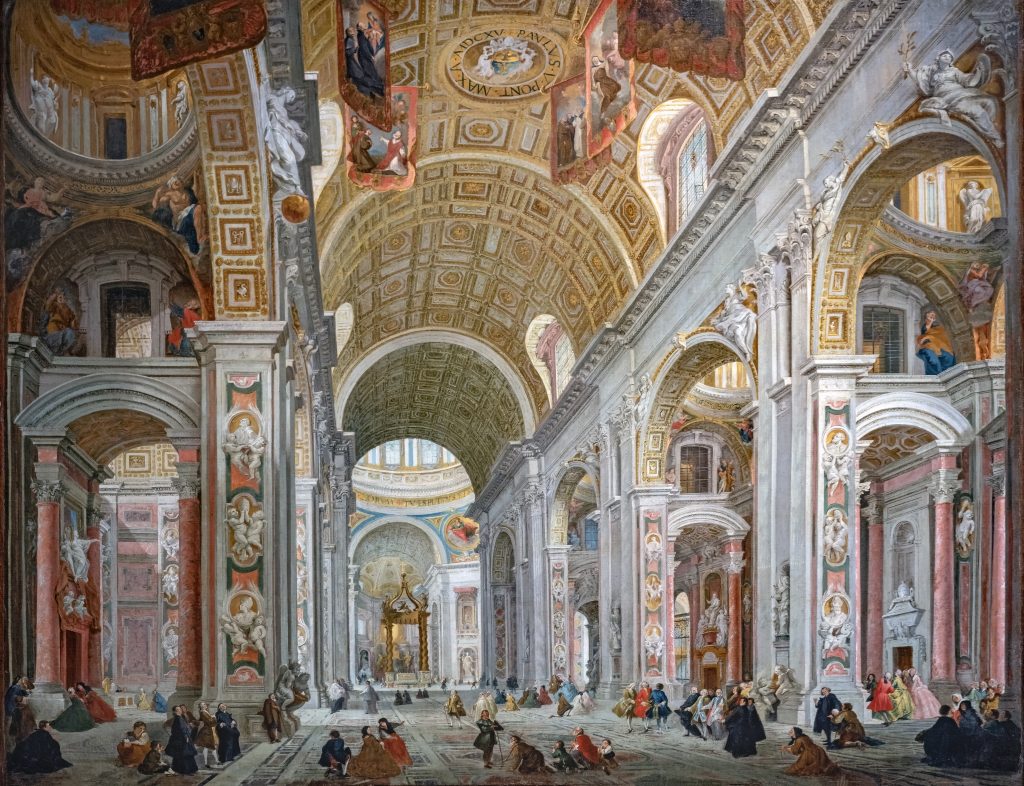Giovanni Paolo Panini, born in Piacenza on 17th June 1691, is one of Italy’s most celebrated artists of the 18th century. Renowned for his grand architectural vistas and imaginative capriccios, Panini’s work offers a fascinating glimpse into the opulence and grandeur of Rome during a period of immense cultural flourishing.
Panini was born into a modest family in the duchy of Piacenza. His early life remains somewhat obscure, however we know he received his initial artistic training in Piacenza.
Showing prodigious talent, he moved to Rome in 1711, where he studied under the tutelage of Benedetto Luti, a prominent painter of the time. This move marked a pivotal turn in his career, providing him access to the rich artistic heritage and vibrant cultural scene of the Eternal City.
Architectural Vistas and Capriccios
Panini’s work is distinguished by his mastery of architectural perspective and his ability to blend real and imagined elements into harmonious compositions. His paintings often depict Rome’s famous monuments and ruins with striking accuracy, infused with an imaginative flair that transforms them into whimsical and theatrical scenes.
One of his signature styles is the “capriccio,” a form of art that combines real architectural elements with fantastical additions, creating a dreamlike vision of reality. This technique allowed Panini to showcase his skill in rendering detailed architectural forms while also engaging the viewer’s imagination.
Notable Works
Among Panini’s most renowned works are his views of Rome’s iconic landmarks. His paintings of the Pantheon, the Colosseum, and St. Peter’s Basilica show meticulous attention to detail and a vibrant depiction of 18th-century Roman life.
His works were very popular with the grand tourists of the time, especially wealthy Englishmen who collected his paintings as souvenirs of their travels.
Interior of St. Peter’s Basilica

One of Panini’s masterpieces, the Interior of St. Peter’s Basilica, exemplifies his skill in capturing the grandeur of Rome’s architecture. The painting immerses the viewer in the vast interior space of the basilica, with its soaring ceilings, intricate details, and the play of light and shadow enhancing the sense of awe.
Ancient Rome

Another significant work is Ancient Rome, a capriccio that brings together various ancient Roman monuments into a single, fantastical composition. This painting not only demonstrates Panini’s architectural prowess but also his ability to create a narrative that celebrates the glory of Rome’s ancient past.
Influence and Legacy
Panini’s influence extended beyond his paintings. He was a respected teacher at the French Academy in Rome, where he mentored a new generation of artists. His teachings emphasised the importance of architectural accuracy and imaginative composition for which he was so well-known.
His legacy is particularly evident in the works of his contemporaries and successors, who continued to explore and expand the genre of architectural painting. Panini’s ability to combine realism with fantasy laid the groundwork for future artists who sought to capture the spirit of Rome in their works.
Giovanni Paolo Panini’s contribution to art lies in his exceptional ability to blend the real with the imagined. His paintings remain a testament to the grandeur of 18th-century Rome.





